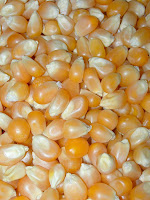The Karnataka version of this is called Nucchinunde. Telugu - Kanduntlu. A traditional South Indian recipe, it is being made less often because it is a little labour intensive. However, with some planning and pre-preparation, this can even make it's way into week-day lunch boxes. It adds valuable protein and fibre to a meal. I've included a snapshot of the magazine article to give a sense of what the finished product looks like.
INGREDIENTS FOR PIDIKOZHAKATTAI:
Whole channa - ½ cup
Green gram – ½ cup
Karamani – ¼ cup
Tuar dal – ½ cup
Whole Urad – 2 tbsp
Cabbage (finely shredded) – ¼ cup
Carrot (grated) – ¼ cup
Onions (finely chopped) – ¼ cup
Curry leaves – finely chopped
Ginger- 1 inch piece
Red chillies – as required (6 for spice)
Salt – to taste
METHOD:
1] Soak all pulses together for 4 hours and then drain
excess water completely.
2] Mix in the ginger, red chillies, salt and coarsely grind
to a rough, chunky texture. Add in the vegetables and curry leaves and mix by
hand. Form oblong rolls with tapered edges roughly 2.5 inches in length and 1.5
inches in thickness. Size them according to your convenience.
3] Place these rolls in idli plates and steam for 15 – 20
mins. Dip a knife into the centre of the roll, if it comes out clean, it’s
cooked.
4] Serve hot with Jeera rasam.
Makes: 18
– 20 nos. Cooking
Time: 20 mins
INGREDIENTS FOR JEERA RASAM
Rasam powder – 1 tbsp
Tamarind – 1 small lemon sized ball
Small tomatoes (finely chopped) – 2 nos
Salt - to taste
Coriander leaves – for garnishing
Seasoning – Oil / Ghee – 1 tsp, mustard seeds and jeera
FOR THE RASAM POWDER –
Coriander seeds (dhaniya) - 1 tbsp
Pepper corns – 1 tbsp
Jeera -1 tbsp
Tuar dal – 1 tbsp
Red chillies – 3
Turmeric powder – 1 tsp
Asafoetida – a pinch
Curry Leaves – 2 twigs
METHOD
1] Roast all the rasam powder ingredients together
(including curry leaves and roast till dry and slightly aromatic). Grind to a
fine powder.
2] Soak the cleaned tamarind in 1 cup (200ml) of water and
heat till warm. Set aside. When cool, extract every last bit of juice from the
tamarind pulp. Throw the dregs.
3] Heat 2 cups of water in a pan and add the finely chopped
tomatoes and bring to a boil. Then add the tamarind water and rasam powder, add
1 more cup of water and boil for 5 more mins. Add salt and wait for a light
that foam accumulates on the surface. The flame should be turned off at this
point.
4] Heat the oil / ghee in a small pan, add in the mustard
and once it splutters, add the rest of the ingredients.
5] Add this seasoning and coriander leaves garnish and serve
piping hot with the nutritious pidikozhakattais.
Cooking Time: 15 –
20mins
Nutrition Tips:
- If this is your meal’s main dish, each person
will probably need 5 rolls with rasam, prepare another vegetable dish and you
can serve everything with red or brown rice. Powder in the pidikozhakattai with
the rice, add rasam and enjoy!
- Sprout all the pulses required to add to the nutrient
value (however this will go 'off' more quickly so consume it all fresh).
- Experiment with different pulses (tuar and channa are a must) and add different herbs and spices to suit your family’s taste buds.
-
This recipe combo was published in Parent Circle, August, 2012.










